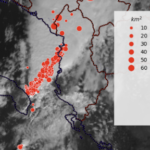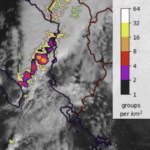Our ESWD team extracted the 10 most deadly flash flood events from the European Severe Weather Database for Spain. Here is the overview:
| Rank | Number of fatalities | Date | Place or region |
| 1 | 5000 * | 13 OCT 1403 | Mallorca island |
| 2 | 777 likely >1000 including Orihuela | 14+15 OCT 1879 | Murcia (region) |
| 3 | 815 | 25 SEP 1962 | Vallés Occidental (region, Catalunya) |
| 4 | >200 ** | 29 OCT 2024 | Valencia urban area (Valencia) |
| 5 | 87 | 07 AUG 1996 | Biescas (Aragon) |
| 6 | 85 | 09 OCT 1787 | Tortosa (Catalunya) |
| 7 | 84 | 19 OCT 1973 | Puerto Lumbreras (Murcia) |
| 8 | 81 | 14 OCT 1957 | Valencia urban area (Valencia) |
| 9 | 50 | 18+19 OCT 1973 | Albuñol Valley (Andalucia) |
| 10 | 33 | 06 OCT 1863 | Llobregales (Valencia) |
* The number of fatalities of this medieval event comes with a large uncertainty.
** Number of fatalities as of 2 November 2024. The official numbers are not final yet and likely to change.
The fact that nearly all events occurred in the month of October is striking. The flood event of 29 October 2024 is the deadliest in Spain in more than 60 years and the deadliest so far this year in the whole of Europe and the Mediterranean, i.e. in all regions covered by the ESWD.
We plan to post an in-depth meteorological analysis of the event early next week.
Note: This article was originally posted on 31 October 2024 at 18 UTC and updated at 20 UTC. The “1962 Vallés floods” event was added with the update. The 1962 event ranks on the third position now. We are thankful for a hint to include this important event. Another update on 2 November 2024 at 20 UTC corrected fatality numbers for events on 25 September 1962, 14+15 October 1879, 18+19 October 1973, and 29 October 2024.



